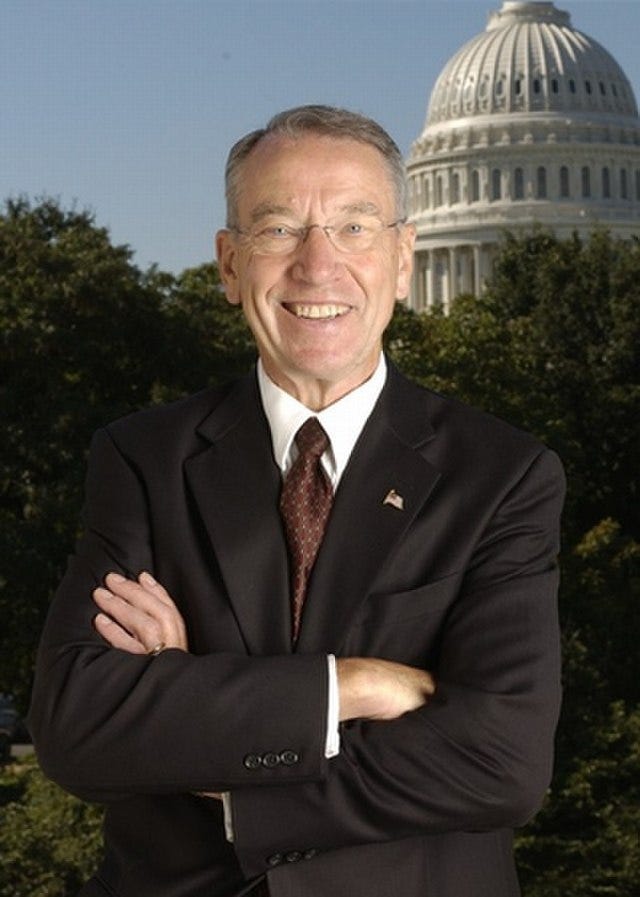Abolishing the D.C. Circuit's 12th Seat
Senator Charles Grassley's years-long campaign
During Bill Clinton’s presidency, Republican senator Charles Grassley determined that the U.S. Court of Appeals for the D.C. Circuit was underworked and did not need the 12th seat that Congress had awarded it in 1984. Grassley’s ultimately successful drive to abolish that 12th seat provides the backdrop for George W. Bush’s nominations to the D.C. Circuit.
***
In October 1995, Charles Grassley, in his capacity as chairman of a subcommittee of the Senate Judiciary Committee’s subcommittee, held a hearing on the D.C. Circuit’s caseload. That hearing, Grassley explained in his opening remarks, was “about the prudent use of taxpayers’ money” and in particular about “whether, based on workload …, a vacancy on the D.C. circuit should be filled at this particular time.”
As it happens, the particular vacancy that Grassley was pondering was one to which Bill Clinton, just six weeks earlier, had nominated a senior Department of Justice official by the name of Merrick Garland. Abner Mikva, a mentor of Garland’s, had resigned his seat on that court in order to become White House counsel. And, after an aborted effort to nominate the arch-liberal Peter Edelman to Mikva’s seat, the White House instead settled on Garland.
Garland’s appointment would return the D.C. Circuit to full capacity. At Grassley’s hearing, D.C. Circuit chief judge Harry Edwards and his fellow D.C. Circuit judge Laurence Silberman sparred over whether the court needed its 12th seat. Edwards cited the court’s increased case backlog (“almost 70 percent greater now than it was in 1983 and 1984”), and he argued that the court’s complex caseload made the raw number of case filings an inapt basis for comparison with other circuits.
Silberman countered that the court’s case backlog was no higher than what was needed in order to “have a stock of cases … to be able to schedule for the [coming] year.” He maintained that the court was “full at 11” members, and he pointed out that it had rarely had 12 judges over the past decade. He recommended that, rather than just being left empty, the 12th seat be abolished.
In September 1996, with Garland’s nomination still pending, Grassley followed Silberman’s recommendation and sponsored a bill to abolish the vacant 12th seat. But at the end of August 1996, Reagan appointee James L. Buckley took senior status. That meant that the court had only ten active judges, so Garland’s appointment would take it to eleven.
In March 1997, the Republican-controlled Senate confirmed Garland’s nomination by a vote of 76 to 23. Grassley was among those voting no. In his floor statement, Grassley stated that he had “closely studied the D.C. circuit for over a year now” and “can confidently conclude that the D.C. Circuit does not need 12 judges or even 11 judges.” Grassley decried the “waste of taxpayer money—to the tune of about $1 million per year for each seat.”
***
Senator Grassley, who took pride in his frugality, bristled at suggestions that partisan ulterior motives underlay his proposal to abolish the D.C. Circuit’s 12th seat. In fairness to him, I am willing to credit his sincerity, even as there is little doubt that various other opponents of Garland’s nomination had other reasons to encourage his efforts.
When George W. Bush became president in 2001, he inherited three D.C. Circuit vacancies. Grassley was adamant that the 12th seat not be filled. That’s why Bush’s initial slate of appellate nominees in May 2001 had only two D.C. Circuit picks, Miguel Estrada and John Roberts. Yet another vacancy arose in September 2001, putting the D.C. Circuit down to eight active judges.
Roberts was finally confirmed to his seat in May 2003, right in the midst of Senate Democrats’ filibuster of Estrada’s nomination. Only in late July 2003, when it appeared very likely that the filibuster against Estrada would defeat his nomination, did Bush nominate Janice Rogers Brown and Brett Kavanaugh to the other existing vacancies.
In November 2003, Grassley again sponsored a bill to eliminate the D.C. Circuit’s 12th seat.
As we have seen, in 2005 Grassley blocked any further action on Kavanaugh’s nomination until another vacancy arose, so that Kavanaugh would not be filling the 12th seat.
***
In January 2008, George W. Bush signed into law the Court Security Improvement Act of 2007. Section 509 of that Act effectively transferred the D.C. Circuit’s 12th seat to the Ninth Circuit: it lowered the number of D.C. Circuit judges from 12 to 11 and increased the number of Ninth Circuit judges from 28 to 29.
Ironically, it was the seat last held by Judge Harry Edwards, who had testified against Grassley’s proposal, that ended up getting abolished.



